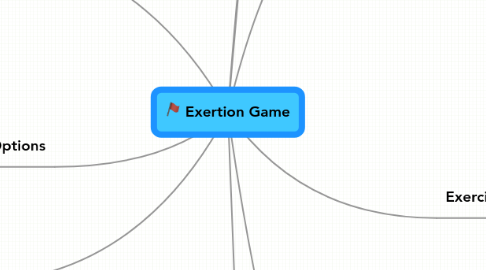
1. Sensor Types
1.1. Accelerometer
1.1.1. Spin
1.2. Camera
1.3. Compass
1.4. Orientation (Phone)
1.5. Light
1.6. Infrared
1.7. Touch
1.7.1. Capacitive DIY..
1.8. Force/Torque
1.8.1. Push/Press
1.8.2. Pull
1.8.3. Twist
1.8.4. Bend
1.9. Body Sensor (Pulse, Blood Pressure)
1.10. Microphone
1.11. Temperature
1.12. Proximity/Distance
2. Game Types
2.1. Single-Player
2.2. Multi-Player at same computer
2.3. Networked Multi-Player
2.4. Against each other
2.5. Cooperative
2.6. Aim for points (Highscore) (also for Single-Player)
3. Sensor Input
3.1. Phone Movement
3.2. Gesture Detection
3.3. Don't create input directly, but indirectly (e.g. shooting a ball against a sensor)
3.3.1. Or put the sensor into the ball
3.4. Body Sensors (measure the exercise effect: pulse, sweat)
3.5. Generate electricity (exercise bike)
3.6. User interacts with water (e.g. pressing balloons filled with water). We detect the interaction by monitoring the water levels (displacement).
4. Game Ideas
4.1. Something that is not as easy in "real" (e.g. Food Fight)
4.2. We should not just simulate a "real-life" sport.
4.3. Place sensors at hard to reach places (e.g. touch sensors on a wall -> jumping/climbing movement)
4.4. Place sensors in a way that requires a specific movement to activate them (e.g. touch sensors on the floor in a push-up position)
4.4.1. Concrete Idea: We have a mat on the floor with touch sensors and lights. Users play against each other over the network (they should not be able to see each other). The first user places himself in a difficult position on the mat. The system detects the sensors being pushed in this position. On the mat of the second player the touched points light up and the second player then has to try to position himself on the map, so that all the light up points are touched and the sensor input matches the input from the first player.
4.4.2. Cheap dance mats could be used
4.4.3. Laser spiderweb - don't get into the rays
4.4.4. Single player (computer generated pattern) with time
4.5. Collaboratively create art (e.g. painting through body movements)
4.6. Game for the mobile phone that gives you abstract goals to achieve (e.g. change your altitude by 10 meters). You have to get creative and use your current environment to achieve the goal.
4.7. Funfair attraction simulation
4.7.1. High striker
4.7.2. Coconut shy
4.7.3. Darts
4.7.4. Knife throwing
4.8. Cooking simulation
4.9. "Schlag den Raab" games
4.9.1. Lighting buttons
4.9.2. Slingshot
4.10. Air drumming
4.11. Simon game but with physical gestures
5. Game Options
5.1. Time Limits to make it more strenuous
6. Technologies
6.1. Flash/Flex
6.2. Processing
6.3. Java
6.4. Quartz Composer
6.5. Cocoa
6.6. Cocoa Touch
6.7. (Android)
6.8. OpenGL
6.9. Max/MSP/Jitter
7. Exercises
7.1. Fitness (Bodyweight Exercises)
7.2. Dancing
7.3. Combat/Martial Sport
7.4. Should not need additional equipment like ball, weights, ...
7.5. Abstract movement that makes no sense on its own but provides input
7.6. Isometric exercises (measured by force sensors)
7.7. Rhythmic / Beat-based movements
7.8. Concrete Movements
7.8.1. Punching/Kicking an object (heavy bag/ball) - sensors in the object
7.8.2. Moving weights instead of controllers (accelerometer in weights / more strenuous)
7.8.3. Move an object onto a sensor (e.g. kick a ball against a sensor, sledgehammer on a sensor)
8. Mobile (Phone) Application
8.1. We have no spatial constrains.
8.2. Outdoor Activities
8.3. We can track location changes
8.4. Use of the outdoor environment (obstacles).
9. General possible approaches
9.1. Re-enact a real sport
9.1.1. Contra: real sport is in general more interesting
9.1.2. Maybe modifications possible that are not possible in the real world.
9.2. Use exertion input for a classic computer game
9.2.1. Contra: exertion interface is just a add on
9.2.2. We are limited in what we can implement in a few weeks (graphics)
9.2.3. Example: Sokoban
9.3. Extend a real sport with virtual objects
9.3.1. Pro: possibly the best approach as it combines both worlds
9.3.1.1. The real-world sport does not need sophisticated graphics!
9.3.2. Kinds of virtual objects
9.3.2.1. Objects that have to be hit
9.3.2.2. Objects created by body movements
9.3.2.2.1. Patterns
9.3.2.2.2. Sounds (Beats)
9.3.2.2.3. Graphics
9.3.2.3. Obstacles
